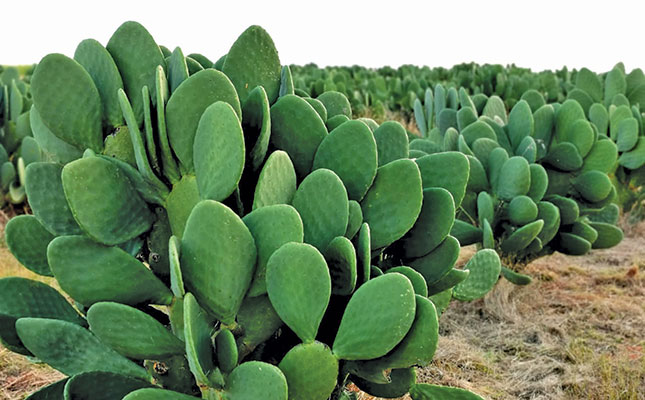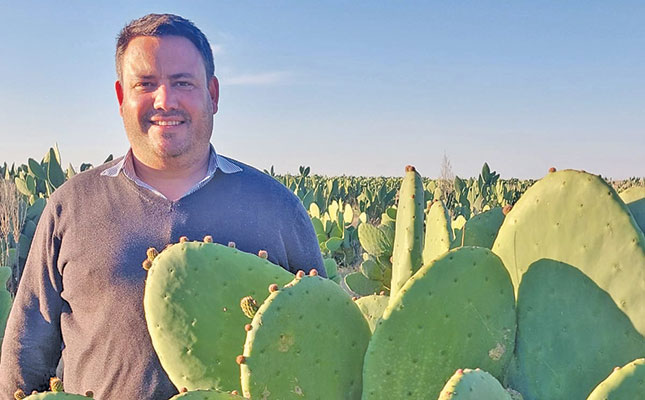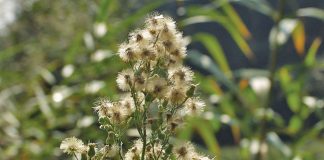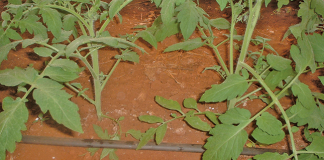
Photo: Witkraal Farming
Dewald van der Berg and his two brothers, Rudolf and Christof, have a mixed farming operation on the farm Witkraal, near Petrusburg in the Free State, which they took over three years ago after the death of their father. While all three are part-time farmers, Van der Berg is in charge of running the family business, Witkraal Farming.
He is convinced that making cactus pear production part of their operation as an additional source of income was one of their best decisions.
According to him, the brothers first realised the value of cactus pear production about 12 years ago.

“We were attracted to this crop because of the fact that it could be planted in the semi-arid Petrusburg area under dryland conditions.
“When we first started growing cactus pear, the plan was to produce cactus pear oil, as well as cladodes as fodder for livestock herds on the farm. However, over the years the business evolved in such a way that Witkraal Farming now concentrates primarily on cladode production,” explains Van der Berg. (Cladodes are modified stems that resemble and function as leaves.)
Disease-free produce
The farm has 70ha of established cactus pear orchards, with another 30ha planted earlier this year. At the time of Farmer’s Weekly’s visit, an additional 30ha were being prepared for planting later in the year.
The aim is to produce disease-free cladodes of the highest quality for buyers and prospective clients. Currently, 16 cultivars are grown on the farm, of which 10 are being evaluated to see how they fare under local conditions.
Van der Berg says a number of these varieties show promise, but it is still too early to gauge accurately.
“One variety in particular, which I came upon on a farm in the eastern Free State, may be a completely new variety, with fruit that ripens very late in the season. I’m very excited about it, but we first need to evaluate it under local conditions to make sure it has the qualities that we hope it does,” he says.
Commercially available cultivars
Six of their varieties are commercially available at present; they are Morado, Meyers, Algerian, R1259, Skinners Court and Gymno Carpo. Van der Berg describes Morado as an all-rounder for oil and fodder production, and says it produces high volumes of good-quality fruit and cladodes. He adds that the Algerian is also an excellent choice, with large quantities of fruit and cladodes. The flesh of the fruit is an attractive pink-red colour and quite tasty.
However, according to him, the fruit of Skinners Court is the best of all; a green-fleshed variety, it offers excellent taste and texture.
The brothers sourced their first plant material from the now late Danie van Tonder, who farmed on Waterkloof near Bloemfontein, and his son DF van Tonder, who now runs the farm. Waterkloof was also home to trials conducted by the University of the Free State on more than 40 varieties of cactus pear.
Planting perfect cladodes
On Witkraal, cladodes are planted by hand, and the average crop yields between 70t and 100t of wet material. According to Van der Berg, the ideal cladodes for planting are at least a year old. By this stage they have reached maturity and have the capacity to store sufficient water reserves, thereby increasing their resistance to frost.
At least 30cm of topsoil is required, and while most of South Africa’s soil types are suitable for cactus pear production, good drainage is essential. As Van der Berg puts it, the plants “don’t like having wet feet”. In short, he stresses, the better the soil, the better the plants will perform.
The cladodes are planted at 2,5m intervals in ripped rows 5m apart, which enables tractors and other machinery to be manoeuvred easily between them. Plant density is 800 plants/ha.
Although the trees only reach full maturity about four years after planting, they begin to bear a small harvest within 18 months.
“Some producers maintain a distance of 2m between the plants. They still do well, but we prefer to use 2,5m, as it makes it easier for us to prune and inspect the plants for pests and diseases,” says Van der Berg.
Orchard management
Cactus pears have extremely high heat and drought tolerance. They can also endure high rainfall, provided they are planted in well-drained soil. The plants are resistant to cold temperatures, although young plants are fairly sensitive to frost.
According to Van der Berg, the plants fare well in the central parts of South Africa, and he considers the climate and rainfall in Petrusburg to be ideal for production.
It’s a fallacy that cactus pear orchards don’t need much management because of the plants’ hardiness and adaptability, he adds. The orchards need to be cleared of weeds and inspected for pests on a regular basis. The plants require fertiliser at planting, and every year thereafter before the start of the new growing season.
“We normally fertilise our plants once a year in late spring, just before the first rain. They respond well to nitrogen, so we use a nitrogen-rich fertiliser at about 200g to 250g per adult plant, which we spread at the base. However, we’re in the process of reviewing our current fertilisation practices due to the steep rise in fertiliser prices,” he says.
Pests
Cladode production is labour-intensive, and pruning and harvesting are carried out manually. Van der Berg avoids using chemicals to treat pests and diseases, as buyers are resistant to this kind of management.
The two main pests on Witkraal are cochineal (Dactylopius coccus) and the cactus moth (Cactoblastis cactorum), and the orchards are inspected once a month by a team of workers. Cochineal outbreaks have been reduced to the bare minimum, and should a few of these scale insects be spotted, they are simply killed by hand.
“This may sound primitive, but because we’ve followed this practice for a number of years, we’ve managed to virtually eliminate the cochineal threat. We go through the orchards quite often to ensure that new populations [of cochineal] don’t get a chance to establish themselves,” he says.
Van der Berg adds that while cactus moth is slightly trickier to control, they simply cut off all of the infected cladodes and feed them to their livestock.
“We’ve also installed electric insect traps in orchards where electricity is available, and this has played a big role in reducing cactus moth populations.”
The trees are pruned towards the end of winter, with all the excess cladodes being removed manually using handsaws.
Marketing
Witkraal Farming markets its cladodes on its website, via social and print media, and most importantly, by word of mouth.
“The most important marketing tool is providing every client with quality plant material in order to maintain the good name we’ve built up over the years,” says Van der Berg.
Witkraal has provided plant material to growers from the Western Cape, Limpopo and Botswana, and their typical clients are commercial producers who are looking for new opportunities to diversify their farming businesses.
Van der Berg emphasises the fact that cactus pear production is a valuable option for diversification. For farmers who already have access to fresh produce markets, cactus pear provides them with an opportunity to market even more fresh produce.
Livestock farmers, on the other hand, can grow cactus pear for use as a highly nutritious source of animal feed.
Email Dewald van der Berg at [email protected]. Visit witkraal.co.za.











